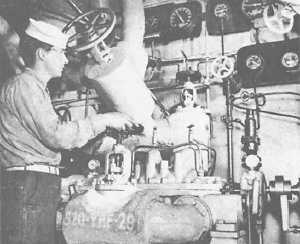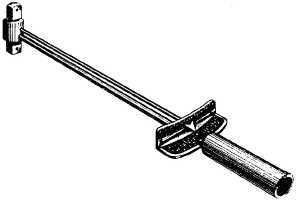Figure 3-7.-Valves.
and
E1 = 900 = 112/5 pounds
8
Slim, the smart sailor, has to lift only 112.5
pounds. There’s a sailor who really puts his
knowledge to work.
THE COUPLE
Take a look at figure 3-6. It’s another capstan-
turning situation. To increase an effective effort,
place a second capstan bar opposite the first and
another sailor can apply a force on the second bar.
The two sailors in figure 3-6 will apparently be
pushing in opposite directions. Since they are on
opposite sides of the axle, they are actually causing
rotation in the same direction. If the two sailors are
pushing with equal force, the moment of force is twice
as great as if only one sailor were pushing. This
arrangement is known technically as a couple.
You will see that the couple is a special example
of the wheel and axle. The moment of force is equal to
the product of the total distance (Ln between the two
points and the force (E1) applied by one sailor. The
equation for the couple may be written
E1 x LT = E2 x L2
APPLICATIONS AFLOAT AND ASHORE
A trip to the engine room important the wheel
and axle makes you realize how is on the modern
ship.
Figure 3-8.—A simple torque wrench.
Everywhere you look you see wheels of all sizes and
shapes. We use most of them to open and close valves
quickly. One common type of valve is shown in figure
3-7. Turning the wheel causes the threaded stem to
rise and open the valve. Since the valve must close
watertight, airtight, or steamtight, all the parts must
fit snugly. To move the stem on most valves without
the aid of the wheel would be impossible. The wheel
gives you the necessary mechanical advantage.
You’ve handled enough wrenches to know that
the longer the handle, the tighter you can turn a nut.
Actually, a wrench is a wheel-and-axle machine. You
can consider the handle as one spoke of a wheel and
the place where you take hold of the handle as a point
on the rim. You can compare the nut that holds in the
jaws of the wrench to the axle.
You know that you can turn a nut too tight and
strip the threads or cause internal parts to seize. This
is especially true when you are taking up on
bearings. To make the proper adjustment, you use a
torque wrench. There are several types. Figure 3-8
shows you one that is very simple. When you pull on
the handle, its shaft bends. The rod fixed on the
pointer does not bend. The pointer shows on the scale
the torque, or moment of force, that you are exerting.
The scale indicates pounds, although it is really
measuring foot-pounds to torque. If the nut is to be
tightened by a moment of 90 ft-1b, you pull until the
pointer is opposite the number 90 on the scale. The
servicing or repair manual on an engine or piece of
machinery tells you what the torque—or moment of
force—should be on each set of nuts or bolt.
The gun pointer uses a couple to elevate and
depress the gun
barrel. He cranks away at a
handwheel that has two handles. The right-hand
handle is on the opposite side of the axle from the
left-hand handle—180° apart.
3-5




